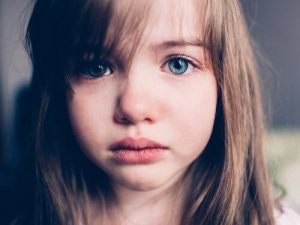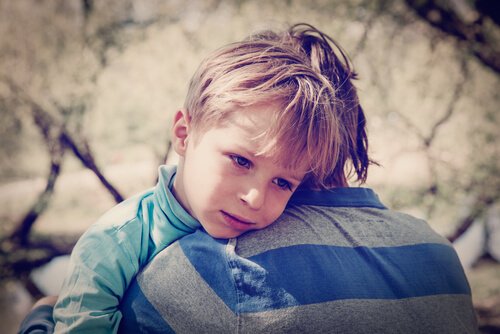Sadness in children

No one is exempt of being sad, not even children. The loss of someone, an unexpected circumstance, a missed opportunity… Sadness in children is more common than we think, that’s why we should be there for them whenever they need us. Educating them in regards to the conscience and emotional regulation is important so they’re able to express their feelings correctly later on.
The movie “Inside Out” (“Intensa-Mente” in Latin American Spanish and “Del Revés” in European Spanish) can help children better understand how important basic emotions are in our lives, as well as recognizing and manifesting them.
Just like fear, happiness or anger, knowing how to channel sadness correctly should be taught from a young age.
Help them understand what sadness really is
When we meet someone who seems to be sad, we usually run in the opposite direction; it’s as if we’re afraid of catching it ourselves, so we always prefer to be around joyful people. But sadness in children, as in adults, is a necessary and essential emotion, and without it, we couldn’t know what joy is really like.
It’s definitely more common to feel this emotion at an adult age due to everything we could’ve possibly gone through up to that point, however, sadness in children can seem somewhat shocking. How strange would it be to find a 5-year-old sitting alone in a bench looking into the horizon or delving into their inner life? We tend to assume that their innocence, their precarious intellectual maturity and their superficial worries should guarantee them solid joy… But that’s not the case.

This doesn’t mean that children can’t feel bad – they can, and in fact, it’s more common than we think; sometimes convenient and other times inevitable. For example, they can feel melancholic due to the loss of a family member or pet, changing schools, new environment…
That’s why the best thing you can do to help is talk to them about sadness and teach them how to indentify it and understand it. Help them understand it’s better to own up to it than hide it, that we all feel that way sometimes and that it’s good to recognize our feelings in order to calm down and let them go.
See also Teach Kids to Recognize Emotions
Ways in which sadness in children is manifested
Just like adults, children can also express their emotional state in different ways. When they’re happy and having fun, it’s normal for them to laugh, play and be joyful; when they’re afraid, they tend to remain motionless and quiet until the shock is over, but when they’re sad, the way they manifest this emotion is not so clear.
Sometimes, they can get to perform opposite behaviors on the same day – behaviors that mask their true state of mind. Let’s see examples of how sadness manifests itself in children:
Hypoactivity: they seem decayed, sleepy, apathetic, indifferent, not talkative, they show lack of appetite… They frequently cry, even when there’s no clear trigger.
Hyperactivity: they eat excessively, they seem anxious, they don’t want to sleep, they’re too talkative.
In order to detect when sadness is dominating in them, parents and guardians must be alert to abrupt changes in their behavior and emotional climate.
How to help them handling sadness
Once you’ve detected unusual or excessive behavior in your child, ask them how they feel. They’ll probably close in on themselves or won’t know how to respond, but we already know that children, during their early stages of development, are like sponges.
Children learn from the emotional expressions of their parents, so they’re basically children’s reference in the emotional field. Parents should explain to their kids that it’s okay to feel sad and that everyone experiences it at some point. However, they must also explain that this emotion becomes more manageable when they understand it, face it and accept it.
Through portraits, drawings or simply talking to them about sadness, you can strengthen their capacity to recognize it. Once they know how to identify it, teach them how to deal with it through examples portrayed by yourself.

What doesn’t benefit them
Sadly, disguising sadness is more “in” than coping with it. From a young age, we’re taught to fake a smile instead of crying and repress our sadness. Coping with our emotions correctly makes it less likely for us to have an emotional outburst later on.
- The mockery: the phrase “you’re a whiner” is tremendously negative when a child is shedding tears. The only thing this does is stop their emotional expressiveness, retract them and force them to hide it. It’s an incredibly negative way to ridicule their feelings.
- Putting them in a hurry: it’s very common for us to demand an answer when our kids don’t respond to our question right away. It’s important to know that they’ll only speak up when they feel like they have your support, no matter how long it takes. It’s vital that you make them feel heard and supported at all times.
- Subtract importance: “That’s nothing, it’s just silly. Don’t be like that”. Saying phrases like this doesn’t help at all, because the triggering event is, in fact, very relevant to them. What you should do is reduce the possible pain or sadness caused by it instead of minimizing its impact.
- Reprimanding or punishing them: “You’re grounded because you won’t stop crying!” There’s only one thing they’ll do after a phrase like this one: stop crying and repress their sadness, so we return to rule one. On the contrary, a hug will help them feel tremendously well and full of strength and energy.
As you can see, the role played by those around kids is key if you want them to understand they shouldn’t be afraid to be sad. Sadness in children should not be overlooked.
This text is provided for informational purposes only and does not replace consultation with a professional. If in doubt, consult your specialist.








